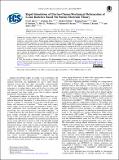| dc.contributor.author | Ipers, Gerrit | |
| dc.contributor.author | Jiao, Junning | |
| dc.contributor.author | Pathak, Shakul | |
| dc.contributor.author | Fang, Ruqing | |
| dc.contributor.author | Berliner, Marc D | |
| dc.contributor.author | Li, Wei | |
| dc.contributor.author | Li, Weihan | |
| dc.contributor.author | Braatz, Richard D | |
| dc.contributor.author | Bazant, Martin Z | |
| dc.contributor.author | Zhu, Juner | |
| dc.date.accessioned | 2024-10-23T20:29:57Z | |
| dc.date.available | 2024-10-23T20:29:57Z | |
| dc.date.issued | 2024-05-01 | |
| dc.identifier.uri | https://hdl.handle.net/1721.1/157410 | |
| dc.description.abstract | Lithium-ion batteries change their geometric dimensions during cycling as a macroscopic result of a series of microscale mechanisms, including but not limited to diffusion-induced expansion/shrinkage, gas evolution, growth of solid-electrolyte interphase, and particle cracking. Predicting the nonlinear dimensional changes with mathematical models is critical to the lifetime prediction, health management, and non-destructive assessment of batteries. In this study, we present an approach to implement an elastoplasticity model for powder materials into the porous electrode theory (PET). By decomposing the overall deformation into elastic, plastic, and diffusion-induced portions and using the powder plasticity model to describe the plastic portion, the model can capture the reversible thickness change caused by Li-ion (de-)intercalation as well as the irreversible thickness change due to the rearrangement and consolidation of particles. For real-world applications of the model to predict battery health and safety, the key lies in solving the mathematical equations rapidly. Here, we implemented the coupled model into the open-source software PETLION for millisecond-scale simulation. The computational model is parameterized using values gathered from literature, tested under varying conditions, briefly compared to real-world observations, and qualitatively analyzed to find parameter-output relations. | en_US |
| dc.language.iso | en | |
| dc.publisher | The Electrochemical Society | en_US |
| dc.relation.isversionof | 10.1149/1945-7111/ad4f1e | en_US |
| dc.rights | Creative Commons Attribution | en_US |
| dc.rights.uri | https://creativecommons.org/licenses/by/4.0/ | en_US |
| dc.source | The Electrochemical Society | en_US |
| dc.title | Rapid Simulation of Electro-Chemo-Mechanical Deformation of Li-ion Batteries Based On Porous Electrode Theory | en_US |
| dc.type | Article | en_US |
| dc.identifier.citation | Gerrit Ipers et al 2024 J. Electrochem. Soc. 171 050557 | en_US |
| dc.contributor.department | Massachusetts Institute of Technology. Department of Chemical Engineering | en_US |
| dc.relation.journal | Journal of The Electrochemical Society | en_US |
| dc.eprint.version | Final published version | en_US |
| dc.type.uri | http://purl.org/eprint/type/JournalArticle | en_US |
| eprint.status | http://purl.org/eprint/status/PeerReviewed | en_US |
| dc.date.updated | 2024-10-23T20:16:43Z | |
| dspace.orderedauthors | Ipers, G; Jiao, J; Pathak, S; Fang, R; Berliner, MD; Li, W; Li, W; Braatz, RD; Bazant, MZ; Zhu, J | en_US |
| dspace.date.submission | 2024-10-23T20:16:45Z | |
| mit.journal.volume | 171 | en_US |
| mit.journal.issue | 5 | en_US |
| mit.license | PUBLISHER_CC | |
| mit.metadata.status | Authority Work and Publication Information Needed | en_US |
